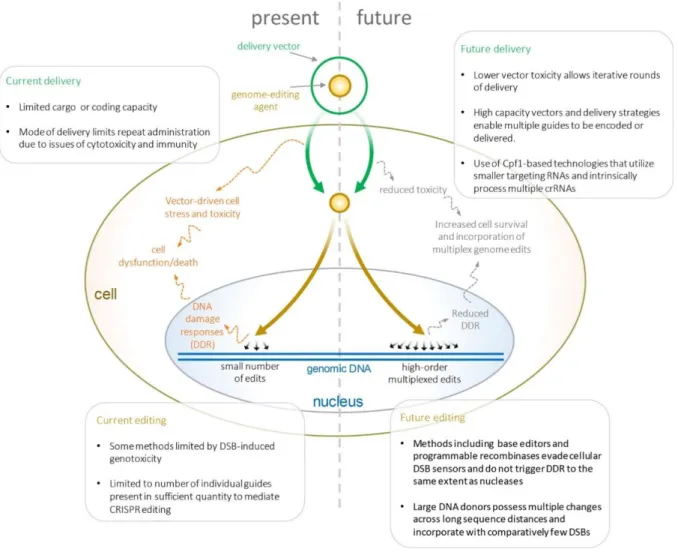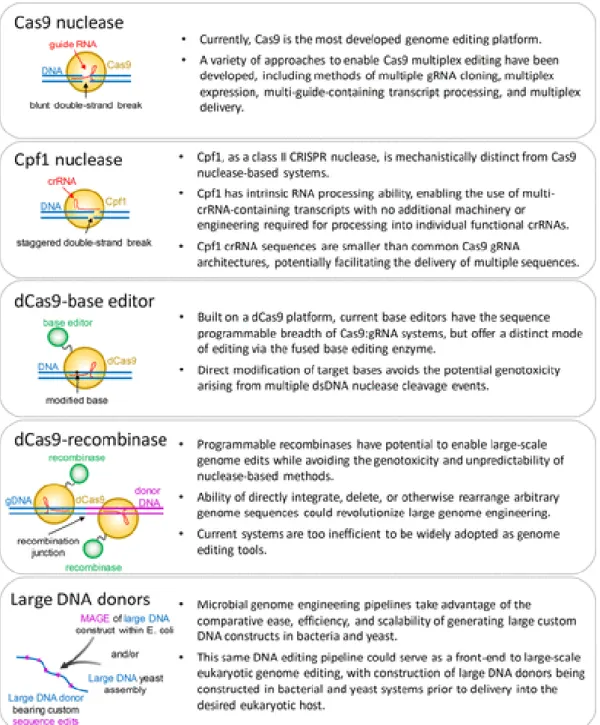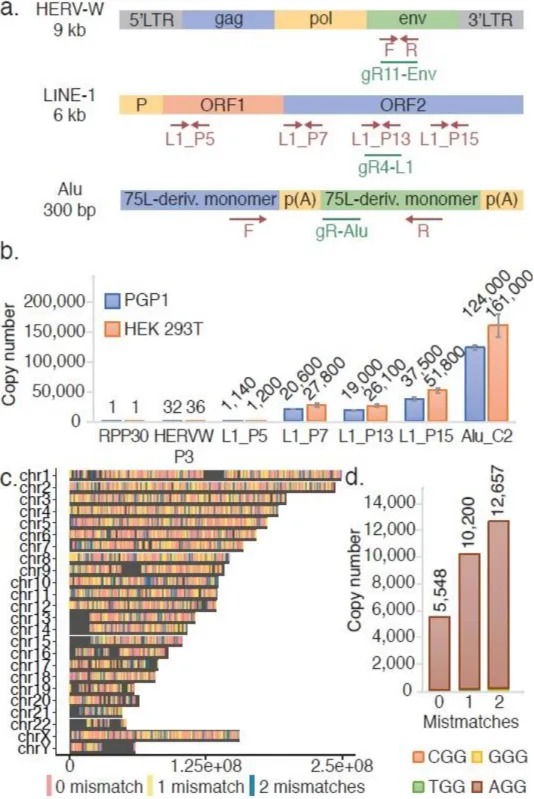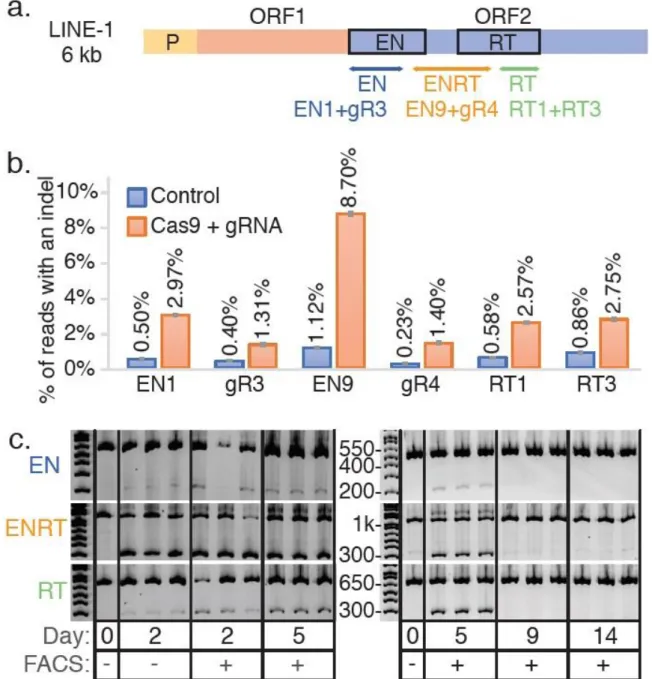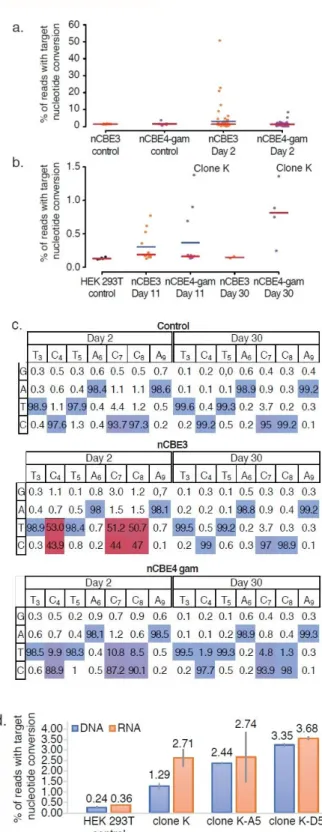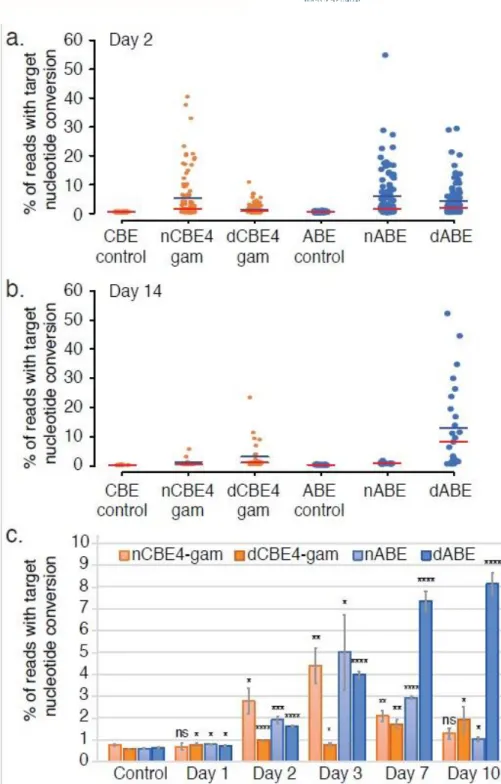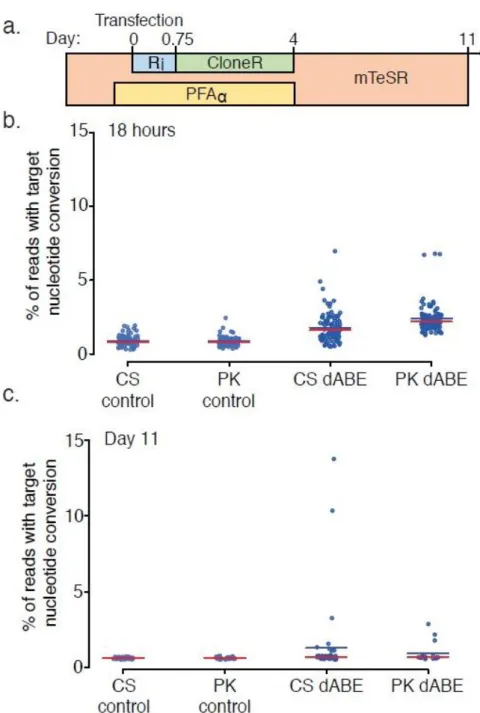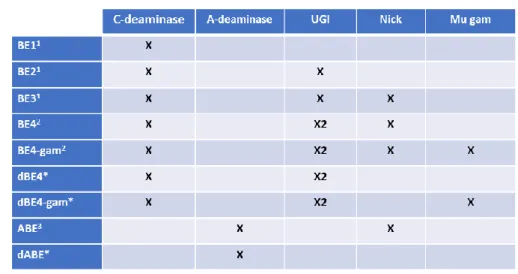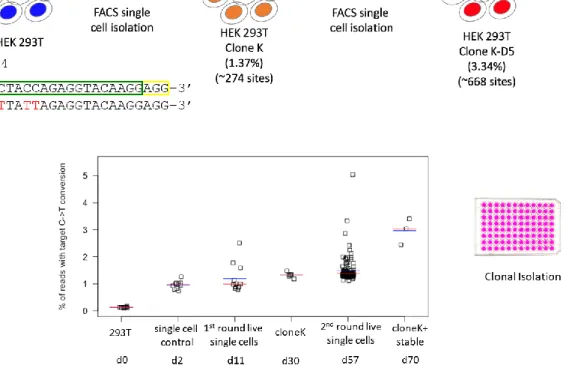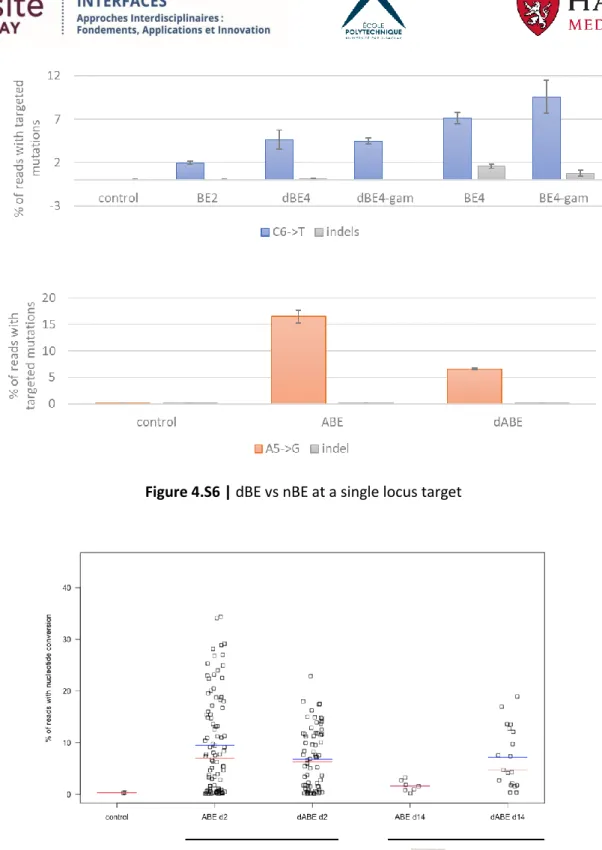HAL Id: tel-02527174
https://tel.archives-ouvertes.fr/tel-02527174
Submitted on 1 Apr 2020HAL is a multi-disciplinary open access archive for the deposit and dissemination of sci-entific research documents, whether they are pub-lished or not. The documents may come from teaching and research institutions in France or abroad, or from public or private research centers.
L’archive ouverte pluridisciplinaire HAL, est destinée au dépôt et à la diffusion de documents scientifiques de niveau recherche, publiés ou non, émanant des établissements d’enseignement et de recherche français ou étrangers, des laboratoires publics ou privés.
Targeting the transposable elements of the genome to
enable large-scale genome editing and bio-containment
technologies.
Oscar Castanon Velasco
To cite this version:
Oscar Castanon Velasco. Targeting the transposable elements of the genome to enable large-scale genome editing and bio-containment technologies.. Biotechnology. Université Paris Saclay (COmUE), 2019. English. �NNT : 2019SACLX006�. �tel-02527174�
Targeting the transposable
elements of the genome to enable
large-scale genome editing and
biocontainment technologies
Thèse de doctorat de l'Université Paris-Saclay
préparée à l’Ecole Polytechnique
École doctorale interfaces n°573 : approches interdisciplinaires,
fondements, applications et innovation (INTERFACES)
Spécialité de doctorat: Biologie
Thèse présentée et soutenue à Palaiseau, le 14 mars 2019, par
Oscar Castanon-Velasco
Composition du Jury :
M. Hannu Myllykallio
Directeur de Recherche, LOB, Ecole Polytechnique
CNRS UMR7645 and INSERM U1182 Directeur de thèse
M. George M. Church
Professeur de Génétique, Blavatnik Institute, Harvard Medical School
Broad Institute & Wyss Inst. of Biologically Inspired Engineering Co-Directeur de thèse
Mme Yad Ghavi-Helm
Chargée de recherche, Institut de Génomique Fonctionnelle de Lyon Univ Lyon, CNRS UMR5241 ENS de Lyon et
Université Claude Bernard Lyon 1 Rapporteur
François Képès
Co-fondateur de la société Synovance,
Membre de l’Académie des Technologies ; Antérieurement,
Directeur de Recherche CNRS à l’université Paris-Saclay (Evry) Rapporteur
M. Ariel B. Lindner
Directeur de Recherche (INSERM),
Centre de Recherches Interdisciplinaires, Université Paris Descartes Examinateur
M. Herman van Tilbeurgh
Professeur de biologie structurale, Université Paris-Sud
CNRS UMR 9198 Président
M. Marc Güell
Professeur Assistant « Tenure-track » de Biologie Synthétique
Page | 1
Dans les champs de l’observation, le hasard ne favorise que les esprits préparés.
---In the fields of observation, chance favors only the prepared minds.
Page | 2
Acknowledgements
This research work would not have been possible without the members of the Laboratory of Optics and
Biosciences (LOB). I want to thank in particular my supervisors Hannu Myllykallio and Hubert Becker for their invaluable guidance to design the research project as well as the LOB’s Director François Hache for his continuous and flawless support. Also, I would like to express my gratitude to the expert members of the jury – François Képès, Ariel Lindner, Yad Ghavi-Helm, Marc Güell and Herman Tilbeurgh
– that have graciously accepted and taken the time to be part of the doctoral committee despite their many responsibilities. Thank you for their kindness and availability.
This PhD work has been realized in collaboration with the Church Lab at Harvard Medical School, where
most experiments have been performed. I would like to thank my co-supervisor George M. Church for providing such a thrilling and exceptional environment in the laboratory, as well as the team I have been closely working with daily. This includes Cory Smith, my brilliant, happy mentor and partner in crime in the lab; Marc Güell and Luhan Yang, my early mentors and talented researchers, whose
teachings early in my PhD were critical for me to reach experimental maturity. Also, it has been a delight to work closely with Parastoo Khoshakhlagh, Khaled Saïd, Chun-Ting, Amanda Hornick and more recently with Raphael Ferreira. Working with all these amazing people led this PhD project to move forward, leading to three publications.
In addition, I would like to acknowledge my mother Iiris, my brother Pablo as well as my late father Manolo – may he rest in peace – for their unflinching moral and intellectual support despite the thousands of miles separating us. Finally, my friends on both sides of the Atlantic Ocean – Mihan,
George Romeo, Aleks, Ingred, Benedikt, Mehdi, Kosar, Antoine, Sébastien, Alain, Yacine, Pierre, Germain, Christelle et Geoffrey to name a few – have been of utmost importance for me to stay healthy in mind and body during my PhD adventures.
Page | 3
Résumé en français
Le ciblage des éléments transposables du génome humain pour développer des technologies permettant son remaniement à grande échelle et des technologies de bio-confinement Mots clés : Génie génétique, CRISPR-Cas9, Base Editing, édition génomique à grande échelle
Les nucléases programmables comme CRISPR-Cas9 sont des signes avant-coureurs d’une nouvelle révolution en génie génétique et portent en germe un espoir de modification radicale de la santé humaine. Le « multiplexing » ou la capacité d’introduire plusieurs modifications simultanées dans le génome sera particulièrement utile en recherche tant fondamentale qu’appliquée. Ce nouvel outil sera susceptible de sonder les fonctions physiopathologiques de circuits génétiques complexes et de développer de meilleures thérapies cellulaires ou traitements antiviraux. En repoussant les limites du génie génétique, il sera possible d’envisager la réécriture et la conception de génomes mammifères. Le développement de notre capacité à modifier profondément le génome pourrait permettre la création de cellules résistantes aux cancers, aux virus ou même au vieillissement ; le développement de cellules ou tissus transplantables compatibles entre donneurs et receveurs ; et pourrait même rendre possible la résurrection d’espèces animales éteintes.
Dans ce projet de recherche doctoral, nous présentons l’état de l’art du génie génétique « multiplex », les limites actuelles et les perspectives d’améliorations. La découverte du système immunitaire adaptatif chez la bactérie a permis le développement de l’outil d’édition génétique CRISPR-Cas9. Sa modularité dû en particulier à la petite taille, le faible coût et la production rapide des ARN guides ou « gRNAs » qui le constituent permet pour la première fois de « multiplexer » l’édition génétique chez les cellules et organismes mammifères. Cette technologie ouvre enfin la voie au criblage parallèle à haut-débit de séquences d’intérêt ainsi que la modification simultanée de plusieurs cibles génomiques. Par ailleurs, CRISPR-Cas9 peut également réguler l’expression de plusieurs gènes en les activant ou les inhibant de manière simultanée. Malgré les promesses d’un tel outil, il est important d’en souligner les limitations : la nucléase Cas9 doit parfois être intégrée et exprimée au cours du temps au sein du génome, causant potentiellement des translocations et autres anomalies dans les cellules dans lesquelles elle est présente ; aussi, la génération de cassures double-brins dans le noyau peut provoquer les réponses apoptotiques qui réduisent de manières drastiques le nombre de cellules pouvant survivre le processus. Par conséquent, les futures applications, qu’elles soient académiques, thérapeutiques ou industrielles, requérons des améliorations substantielles en termes d’efficacité de l’outil et de viabilité des cellules afin de déverrouiller le remaniement du génome à grande échelle. La technologie du « base editing » – qui permet la conversion d’une cytosine (C) en Thymine (T) (ou Guanine (G) en Adénine (A) sur le brin complémentaire) ou A → G (ou T → C sur le brin complémentaire) – apporte de la précision tout en préservant son efficacité et réduit la toxicité et les aberrations chromosomiques par rapport aux nucléases générant des cassures double-brins. Les « base editors » sont par conséquent de solides candidats pour permettre les modifications génétiques à l’échelle du génome.
Page | 4
Nous tirons profit de la technologie du « base editing » ainsi que de la multitude d’éléments transposables présents dans notre ADN pour construire une plateforme d’optimisation et développer de nouveau outils permettant le remaniement du génome à grande échelle. La difficulté d’introduire plusieurs gRNAs dans une même cellule ainsi que la génotoxicité des éditeurs génétiques actuels sont les deux obstacles majeurs afin de rendre possible le « multiplexing » génétique. Nous essayons ici de surmonter le deuxième obstacle pour développer des éditeurs génétiques plus sûrs que nous testons via le ciblage des éléments transposables du génomes tels que les virus endogènes humains de type W (HERV-W), les « Long-interspersed nuclear éléments-1 » (LINE-1) et Alu. Ces transposons constituent des cibles attrayantes puisque leur haut niveau de conservation nous permet de concevoir un nombre limité de gRNAs ciblant simultanément un nombre de séquences allant de plusieurs dizaines de milliers à plusieurs centaines de milliers. Initialement, le ciblage d’éléments transposables par le système CRISPR-Cas9 générant des cassures double-brins et l’identification de cellules hautement modifiées n’ont pas eu de succès. Nous avons alors conçu et testé des gRNAs ciblant les séquences LINE-1 en utilisant les « nicking Base Editors (nBEs) » – ne générant qu’une cassure simple brin. Cette stratégie a permis la génération de clones cellulaires HEK 293T contenant jusqu’à 781 modifications. Des modifications génétiques de cette ampleur n’avaient jamais été démontrées jusqu’alors.
Afin de continuer à améliorer ces outils d’édition génétique, nous avons décidé d’inactiver le site enzymatique catalysant la cassure simple brin restante des nBEs, générant deux nouvelles enzymes – dCBE et dABE – en se basant sur l’hypothèse que les cassures simple brin au niveau des éléments répétés du génome contribuaient fortement à la toxicité cellulaire observée. Cette stratégie a permis l’identification de clones cellulaires présentant un nombre de modifications deux ordres de magnitudes supplémentaires par rapport aux cellules editées via les nBEs, avec plus de 13200 modifications dans la lignée cellulaires HEK 293T et 2600 modifications dans des cellules souches pluripotentes induites (ou iPSCs), soit le plus grand nombre de modifications génétiques simultanées jamais observé, par conséquent établissant un socle pour l’écriture des génomes de mammifères. En outre, l’observation de la toxicité engendrée par la multitude de coupures double-brins dans le génome nous a amené à développer un bio-interrupteur susceptible d’éviter les effets secondaires des thérapies cellulaires. Cette technologie s’appuie sur la toxicité générée par le ciblage des éléments Alu par un système Cas9 conditionnel induit par la doxycycline. Expérimentalement, ce système « suicide » permet l’élimination de 99.98% des cellules. Par ailleurs, nous démontrons que la doxycycline n’est pas toxique pour les cellules et que le système ne s’active pas spontanément en l’absence de la molécule inductrice. Ces deux caractéristiques sont en effet absolument requises pour un potentiel développement en clinique.
En conclusion, nous exposons les considérations éthiques qu’apporte le domaine du génie génétiques et apportons des pistes de réflexions pour diminuer les risques identifiés.
Page | 6
Table of Contents
Acknowledgements ... 2 Résumé en français ... 3 Abbreviations ... 9 1. General Introduction ... 121.1. The central dogma of biology: DNA, RNA and proteins ... 12
1.2. CRISPR-Cas9: From bacterial immune system to genome editing tool ... 15
1.3. The CRISPR-Cas9 revolution: From single edits to whole-genome recoding ... 17
1.4. Experimental strategy and research outline ... 19
2. Transposable Elements of the Genome ... 21
2.1. Introduction ... 21
2.2. LINE-1 ... 22
2.3. Alu ... 23
3. Multiplex Genome Editing Technologies ... 26
3.1. Introduction ... 26
3.2. The State of Multiplex Genome Editing Technologies ... 27
3.2.1. Multiplex Editing in Eukaryotic Genomes ... 27
3.2.2. Strategies for Multiplex Guide RNA Expression ... 30
3.2.3. Lessons from Bacterial Genome Engineering ... 32
3.3. Application of Multiplex Genome Editing ... 33
3.3.1. Combinatorial Functional Genomic Methods ... 33
3.3.2. Therapeutic Application of Multiplex Editing ... 34
3.3.3. Genome Writing ... 35
3.3.4. Repetitive Genetic Elements ... 37
3.4. Methods of Multiplex Genome Editing ... 39
3.4.1. Base Editing ... 40
3.4.2. Programmable Recombinases ... 41
3.4.3. Large Donor DNAs ... 43
3.4.4. Generating Large ssDNA ... 45
3.4.5. Programmed Genome Rearrangement ... 46
3.4.6. Multiplex Delivery ... 47
3.4.7. Delivery of Large DNAs... 50
Page | 7
4. Developing Large-Scale Genome Editing Technologies ... 53
4.1. Introduction ... 53
4.2. Methods ... 56
4.2.1. Transposable element gRNA design ... 56
4.2.2. qPCR evaluation of copy number across repetitive element targeting gRNAs - ... 57
4.2.3. SpCas9 and gRNA plasmids used for genome editing ... 58
4.2.4. SaCas9 and gRNA plasmids used for genome editing ... 58
4.2.5. Maintenance and transfection of HEK 293T cells ... 58
4.2.6. FACS Single cell direct NGS preparation ... 59
4.2.7. Single cell clonal isolation and sequence verification ... 59
4.2.8. Nested PCR Illumina MiSeq library preparation and sequencing ... 60
4.2.9. NGS indel analysis ... 60
4.2.10. Dual gRNA deletion frequency NGS analysis ... 60
4.2.11. NGS base editing deamination analysis ... 60
4.2.12. Automated CRISPR and Base Editing pipeline ... 61
4.2.13. Site directed mutagenesis to remove remaining nick from base editors ... 61
4.2.14. Propidium Iodide and Annexin V staining and FACS analysis ... 62
4.2.15. Karyotype analysis of LINE-1 dBE-edited 293T single cell clones ... 62
4.2.16. Maintenance and expansion of human iPSCs ... 62
4.2.17. Nucleofection in PGP-1 iPSCs ... 63
4.2.18. Clonal isolation of PGP-1 iPSCs ... 63
4.3. Results ... 65
4.3.1. gRNA design and copy number estimation of transposable elements ... 65
4.3.2. CRISPR/Cas9 editing at a range of high copy number targeting gRNA does not allow the isolation of stably edited clones ... 67
4.3.3. nCBE and nABE activities confirmed at LINE-1 ... 69
4.3.4. nCBEs enable isolation of stable cell lines with hundreds of edits ... 71
4.3.5. Nick-less dBE confirmation at a single locus ... 72
4.3.6. Nick-less dBE targeting of LINE-1 in 293T ... 73
4.3.7. dABE activity in PGP1 iPSCs ... 76
4.4. Discussion ... 78
4.5. Supplementary Figures and Tables ... 81
5. CRISPR-mediated biocontainment technologies ... 91
Page | 8
5.2. Methods ... 93
5.2.1. Cas9, sgRNA and anti-CRISPR plasmids used for genome editing ... 93
5.2.2. Human iPSCs cell culture ... 94
5.2.3. Transfection of human iPSCs ... 94
5.2.4. Synthesis and genomic integration of the CRISPR-DS into HEK 293T cells ... 95
5.2.5. Propidium Iodide and Annexin V staining and FACS analysis ... 95
5.2.6. Antibody staining and fluorescent microscopy... 96
5.2.7. Transfection of HEK 293T ... 96
5.2.8. Preparation of HEK 293T samples for Insertions and Deletions (indels) analysis ... 96
5.2.9. Insertions and deletions (indels) analysis ... 97
5.2.10. Illumina MiSeq library preparation and sequencing ... 97
5.2.11. NGS data analysis ... 98
5.3. Results ... 98
5.3.1. Design of the sgRNAs targeting repetitive elements ... 98
5.3.2. CRISPR Defense System prevents the formation of populations harboring DNA edits 100 5.3.3. CRISPR-Cas9 targeting high-copy number loci rapidly causes DNA damage ... 101
5.3.4. CRISPR-DS compared to systems targeting essential genes or using anti-CRISPR proteins 104 5.3.5. Towards the development of a safety switch for cell therapies based on the Cas9-targeting of repetitive elements ... 106
5.4. Discussion ... 109
5.5. Supplementary figures ... 112
6. Ethical and regulatory considerations of genome editing ... 115
7. Research overview & perspectives ... 119
7.1. Multiplexed genome editing: today’s limits and tomorrow’s promises ... 119
7.2. Large-scale genome editing at repetitive elements ... 122
7.3. CRISPR-mediated bio-containment technologies ... 125
List of figures and tables ... 127
Page | 9
Abbreviations
DNA DeoxyriboNucleic Acid ssDNA single-stranded DNA dsDNA double-stranded DNA RNA RiboNucleic Acid mRNA messenger RNA tRNA transfer RNA A Adenosine T Thymine C Cytosine G Guanine U UracilCRISPR Clustered Regularly Interspaced Short Palindromic Repeats
Cas CRISPR-associated proteins spCas9 Saccharomyces pyogenes Cas9 saCas9 Staphylococcus aureus Cas9 nCas9 nicking Cas9
dCas9 dead Cas9 BE Base Editor nBE nicking BE dBE dead BE ABE A to G BE
CBE C to T BE
gRNA or sgRNA single-stranded guide RNA crRNA CRISPR RNA
trRNA trans-activating RNA PAM Protospacer Adjacent Motif
TALEN Transcription Activator-Like Effector Nucleases
ZFN zinc finger nuclease
LINE-1 Long-interspersed Element-1 SINE Short-interspersed Elements HERV Human Endogenous Retro-Viruses PERV Porcin Endogenous Retro-Viruses SRP Signal Particle Recognition DSB Double-Stranded Break SSB Single-Stranded Break RNP RiboNucleic Protein
SSAP Single-Strand Annealing Protein MAGE Multiplexed Automated Genome Engineering
CAGE Conjugative Assembly Genome Engineering
CAR Chimeric Antigen Receptor
Page | 10
HLA-I human leukocyte antigen class I PD-1 programmed death-1
GP-write Genome Project Write ENCODE ENCyclopedia Of DNA Elements
RGE Repetitive Genetic Element TE Transposable Elements HDR Homology-Directed Repair NHEJ Non-Homologous End Joining
ssODN Single-Stranded Oligo DeoxyNucleotide AAV adeno-associated virus
HSV Herpes Simplex Virus
HAC Human Artificial Chromosomes MMCT Microcell-Mediated Chromosome Transfer
HEK 293T Human Embryonic Kidney 293 T- antigen
hiPSCs human induced Pluripotent Stem Cells PGP1 Personal Genome Project 1
RNAseq high-throughput RNA-sequencing NGS Next Generation Sequencing
AcrIIA Anti-crispr protein type IIA JAK2 JAnus Kinase 2
GTFIIB General Transcription Factor IIB PB Piggybac
DOX Doxycyline PI propidium Iodide
CRISPR-DS CRISPR-Defense System RAC Recombinant DNA Advisory Board FDA Food and Drug Administration EMA the European Medicines Agency
Page | 12
1. General Introduction
The recent development of programmable and site-specific endonucleases, such as Zinc-finger enzymes in 1985 and the CRISPR-Cas9 system in 2013, has opened the way to genome engineering. The field can be seen as both a revolution and a threat to society. On the bright side, genome engineering holds the hope to cure genetic diseases such as cystic fibrosis or Huntington without the fear that they will be transmitted to descendants. It may allow us to, one day, eradicate cancer, increase our life spans, bring back extinct species, or even adapt to the radically different environments, that may be required to the realization of our deepest dreams of spatial conquests. On the dark side, genetic engineering brings to surface our fears of eugenics and the possibility of increasing the inequalities of the world by only enhancing individuals that can afford it. Ethics will be of utmost importance to responsibly identify both the opportunities and dangers brought by the ability to edit genomes. However, will our capacity to design genomes will be critical to achieve this human revolution as compared to existing modalities? In that regard, understanding the central dogma of biology can provide us with answers.
1.1.
The central dogma of biology: DNA, RNA and
proteins
The central dogma of molecular biology (Fig. 1.1) relies on three basic building blocks: 1) Long strings of Deoxyribonucleotides (DNA) encodes the information needed for cells to function and is transmitted from generation to generation through the replication process; 2) The coding segments of the DNA are then transcribed into strings of Ribonucleotides (RNA), which are temporary copies of the DNA that it originated from, through a process called transcription; and finally, 3) the RNA transcripts are either directly functional (non-coding RNA such as ribosomal, regulatory RNAs or
Page | 13
tRNAs) or translated into proteins that have a variety of functions, such as stabilizers or catalyzers of essential biochemical reactions. All three processes—replication, transcription and translation—are heavily regulated and allow cells to respond differently according to internal and external stimuli.
Figure 1.1 | Replication, transcription, translation: The dogma of Biology
The human genome is composed of about three billion base pairs distributed into 23 pairs of chromosomes. It includes about 20,000 genes, each one coding for a protein that can lead to the generation of several different variants when modifications occur downstream at the RNA or protein levels. However, the genome is not only composed of genes, but also sequences that do not translate into proteins. In fact, this non-coding DNA accounts for most of our genome and corresponds, for instance, to sequences involved in the regulation of genes. This includes introns, which are segments within genes that are removed a process called splicing, and transposable elements that account for more than 50% of the genome and whose functions are not well understood.
For a cell to pass its information on to the next generation, its DNA must undergo replication, which is divided into three phases. The first step is called initiation. In this process, DNA helicases begin to separate the double-stranded DNA at distinct loci in the genome, termed the origins of replication. From there, the elongation process takes place. In this phase, other protein complexes, including DNA polymerases, are synthesizing a complementary copy of the DNA starting from replication forks. Integration of nucleotides does not occur randomly but follows the so-called Watson-Crick base
Page | 14
pairing, where Adenosine (A) interacts with Thymine (T) and Guanine (G) with Cytosine (C). Finally, the termination happens when adjacent replication forks fuse to generate two independent and identical DNA segments.
DNA is a form of permanent information storage that remains in the nucleus of the cell. Transcription is the process by which this information is turned into a temporary string of RNA that will lead to the generation of proteins during translation. DNA and RNA are not identical copies since they are composed of slightly different units: deoxyribonucleotides versus ribonucleotides. The transcription process involves transcription factors that bind to the promoter and enhancers, sequences upstream of the gene to be transcribed. These transcription factors recruit RNA polymerases and together, synthesize the string of RNA in the 5’ to 3’ orientation using the strand of the gene’s DNA sequence as a template. Similar to replication, three phases describe this process: initiation, in which the RNA polymerase binds to the promoter and separates the DNA strands; elongation, which corresponds to the progressive synthesis of RNA by addition of ribonucleotides based on the DNA template; and finally, the termination step ends with the release of the RNA polymerase and the transcript thanks to the transcription of sequences called terminators.
Once the transcript is generated, it is exported out of the nucleus and charged into the ribosome, the master unit of translation by which proteins are synthesized. The ribosome is a large double-unit-complex made of proteins and RNA that reads through the transcripts using a set of rules, the genetic code, which matches the three-nucleotide units of the transcript, called codons, with one of 20 specific amino-acids. Translation is initiated when the small subunit of the ribosome binds to the start of the RNA sequence. Then, a transfer RNA, or tRNA, which carries an amino-acid (usually a methionine) interacts with the first codon of the transcript through its complementary anti-codon sequence and is followed by the recruitment of the large ribosomal subunit. In the elongation step, the ribosome interacts with tRNAs that successively load their specific amino-acid into the growing polypeptidic
Page | 15
chain. The ribosome catalyzes the generation of a bond in between each incorporated amino-acid. The process is terminated when the translation complex interacts with a stop codon, which triggers the release of the newly synthesized protein as well as the ribosomal complex.
Replication, transcription and translation are highly regulated processes, allowing cells to respond adequately to their environment. For instance, gene expression can be lowered or increased by repressors or activators, RNA can be modified post-transcription through splicing, and proteins can be modified by addition of polysaccharide chains. Such regulations can also explain how we are able to generate a large diversity of proteins from a relatively low gene number.
Since the genome holds the permanent information necessary for life, is transmitted to future generations and comes upstream of the RNA and protein modalities, it constitutes the keystone that can lead to a radical transformation of human health, influence our own evolution or even wipe out species carrying diseases such as malaria. However, with such power, comes great responsibilities, and this necessitates regulation and oversight, which will be discussed later in this dissertation. For now, I will describe more thoroughly CRISPR-Cas9, the programmable nuclease that revolutionized the field of gene editing and that could lead the way towards the customized design of whole genomes.
1.2.
CRISPR-Cas9: From bacterial immune system to
genome editing tool
To develop therapeutic compounds, or study biological phenomena, researchers in academia and industry were widely successful at modulating gene expression by the disruption of RNA and protein levels through the targeted modulation of transcription and translation pathways. Now, purposely engineering the DNA—which holds the permanent form of information needed for life—could
Page | 16
revolutionize fundamental and applied biological research. Unfortunately, this task has proven much more challenging in the past decades when scientists relied on the spontaneous or uncontrolled (through chemicals or transposons) modification of genes (or mutants) to further investigate a phenotype. With the advent of site-specific nucleases such as Zinc-Fingers, TALEN and particularly CRISPR-Cas9 since 2013, modifying the genome has never been more easy or efficient, opening new avenues for fundamental and applied biological research.
CRISPR-Cas9 was initially discovered to be an adaptive immune system for bacteria to protect against viruses and plasmids by targeting and degrading exogenous DNA specifically. This molecular system is composed of “Clustered Regularly Interspaced Short Palindromic Repeats” or CRISPR1 as well as
CRISPR-associated (Cas) genes. CRISPR is a segment of DNA with a succession of repeats and spacers. The spacers are sequences from viruses that have been incorporated into the host DNA and act as a memory to fend off future infections. The Cas9 protein possesses an endonuclease activity that makes DNA double-strand breaks at the location it binds to.
Basically, when a new viral invasion occurs, the corresponding spacer and the adjacent repeat sequence are transcribed and processed into a single stranded CRISPR-RNA (crRNA). The crRNA then complexes with a trans-activating RNA (trRNA). The Cas9 protein interacts with the RNA complex to form a ribonucleoprotein. The ribonucleotide sequence recognizes and binds the complementary strand of the viral DNA, guiding and activating the Cas9 endonuclease specifically against the virus. The target sequence always includes a Protospacer Adjacent Motif (PAM), which is necessary to elicit Cas9 enzymatic activity. This serves as a safety mechanism to prevent targeting of the bacterial CRISPR array where the crRNA is transcribed from and which lacks the PAM.
Since the discovery of this bacterial immune system, researchers have repurposed CRISPR-Cas9 as a genome editing tool. The crRNA and trRNA have been combined into one single-stranded guide RNA (sgRNA), and the Cas9 nuclease has been engineered to function in eukaryotic organisms such as
Page | 17
plants and animals. Today scientists can conveniently design and synthesize sgRNAs to target their locus of choice for a wide range of purposes.
1.3.
The CRISPR-Cas9 revolution: From single edits to
whole-genome recoding
CRISPR-Cas9 bears the hopes of curing virtually any monogenic disease, such as beta thalassemia and sickle-cell disease, treatments for which are currently in clinical trials. However, what if curing or understanding a disease meant modifying more than one or ten or even greater than a hundred genes? Would this multiplexing be feasible with current genome-editing technologies?
The ease of use, modularity, efficiency and low cost of CRISPR-Cas9 system are the features that hold the potential of the technology and led to its massive adoption in the scientific community. CRISPR-Cas9 is modular since the endonuclease does not need to be designed for each target and, as mentioned previously, it is the sgRNA that gives the specificity to the system. Designing and synthesizing one sgRNA is fast and costs only a few dollars. This modularity enables what is called multiplexing, which is the ability 1) to highly parallelize gene-editing experiments for drug screening, for instance; and 2) to easily target more than one locus per genome. For instance, a research group broke the record for the number of edits per cell and generated a viable swine cell line with 62 inactivated porcine retroviruses. However, the field of genome editing needs to overcome significant challenges to progress towards the full recoding of mammalian genomes. Notably, the stress induced by DNA double-stranded breaks leads to substantial cell toxicity and genome-wide editing requires the challenging delivery of multiple sgRNAs.
Overcoming these difficulties and enabling fully multiplexed editing could help us understand the poorly characterized portion of the genome that does not include genes, known as “dark matter” most
Page | 18
of which consists of transposable elements. These elements account for more than 50% of our DNA and include Long-interspersed Element-1 (LINE-1), Alu or Human Endogenous Retro-Viruses (HERVs), whose involvement in our physio-pathology mostly escapes scientific knowledge. These elements, initially described as “junk DNA”, are mobile and have actively shaped our evolution. They can duplicate and integrate themselves back into the genome, potentially disrupting gene expression and impacting our physiology. However, the copy number of such elements varies from tens to tens of thousands, which makes their inactivation at the genomic level impracticable with current tools.
In addition, safe large-scale multiplexing of genome editing could enable the recoding of mammalian genomes with a wide range of applications. The past decades have seen the exponential development of DNA sequencing. With the advent of high-throughput technologies we can now sequence a whole human genome for a few hundred dollars in a few hours, while it took three billion dollars and more than 20 years to construct the first draft of the human genome assembly. However, technologies to write DNA in a high-throughput manner—including large-scale editing and synthesis—have not yet reached the level of DNA sequencers. Therefore, in 2016 the Genome Project Write or GP-write initiative was launched in order to drive the scientific community together towards exponentially improving the design, editing, synthesis and assembly of genomes within the next decade. Genome recoding and writing could lead to revolutionary advances in human health, such as generating virus and cancer resistant cell lines, enabling the development of universal donor cell therapies, and engineering xeno-compatible and synthetic organs. However, genome-wide recoding of mammalian DNA will remain inaccessible in the current state of editing technologies since targeting more than a few sequences has already been shown to be highly toxic to eukaryotic cells.
Would it be possible to leverage programmable nucleases such as the CRISPR-Cas9 system to develop tools to massively and safely edit transposable elements or recode mammalian genomes? Why is genome editing at multiple elements toxic to the cell? What are the cellular and molecular
Page | 19
mechanisms in place that prevent heavy DNA modifications? Can we get around these putative pathways to enable massive genome engineering? Such are the questions that are driving this research project.
1.4.
Experimental strategy and research outline
We chose to use the mobile elements of the genome as a tool and as an interesting biological problem. On one hand, the copy number range of these ubiquitous sequences of the genome will allow us to determine the hard limit for the number of edits that an individual cell can handle, and it will guide us on how to improve and fine-tune these editing tools to break these limits through iterations. On the other hand, as I previously mentioned, inactivating transposable elements will help us better understand their poorly known pathophysiology, since, even though these sequences have been regarded as both opportunistic and junk DNA, recent research has shown that they may be involved in neurological and embryonic development, as well as in cancer and neurodegenerative diseases.
As the large-scale editing project moves forward, the observation that the massive modification of mammalian cells can be highly toxic will lead us to explore the potential development of bio-containment technologies. CRISPR-Cas9 is an exciting technology that brings opportunities to the field of biomedical research. Nevertheless, beyond the positive impact lies the potential for the non-ethical use of the editing tool (e.g. bioterrorism, designer babies, etc.) that motivates the development of countermeasures. Following-up with such concerns, we sought to leverage the observed genotoxic feature of CRISPR-Cas9 targeted to repetitive elements in order to develop a CRISPR Defense System (CRISPR-DS) that ensures the introduction or activation of Cas9 to trigger cell death, rendering cell populations in which the system is active effectively non-editable by Cas9.
Page | 20
Finally, we further leveraged this genotoxic mechanism of action to design a surveillance system aimed at making cell therapies safer. The field of regenerative medicine has boomed in the past few years— partly thanks to the genome editing revolution— and has shown great promises to cure diseases such as acute lymphoblastic leukemia, for which the standards of care are very low. Although the transplantation of engineered cells, tissues or organs have showed impressive results, several risks have been identified, notably, the potential to become oncogenic or trigger the cytokine release syndrome by CAR-T therapies, to name a few. In order to mitigate these risks, the development of safety switches provides the option to selectively eliminate transplanted therapeutic cells in case of adverse effects.
This PhD dissertation will be structured as follows. First, the transposable elements of the genome will be defined and the state-of-the-art of eukaryotic multiplexed genome editing will be outlined. From there, I will describe the research that led to successfully achieving large-scale genome editing at repetitive elements. Finally, I will detail the CRISPR-mediated biocontainment technologies—a project that originated from the observation that the original CRISPR-Cas9 genome-editing tool is highly toxic when targeting high copy-number sequences.
Page | 21
2. Transposable Elements of the Genome
2.1.
Introduction
Transposable elements are wide-spread repetitive sequences in many organisms’ genomes that can duplicate and/or move to a new locus, either autonomously or dependent on another mobile element. Repetitive elements have actively shaped the evolutionary history of eukaryotic genomes and continue to generate novel variants when they duplicate into new loci or are the sites of recombination or translocation. The initial publication of the human genome2,3 showed that up to
two-thirds of the nuclear DNA was repetitive3 and is largely transposon derived (Fig 1.2). This large
fraction of the genome was initially labeled as junk, nevertheless they are correlated with some of our most important physiological processes and can act as a potential cause of disease when duplicating and affecting the expression of key genes.
The most widespread transposable elements are the Long-Interspersed Elements-1 or LINE-1, an autonomous non-LTR class I retrotransposon that constitutes about 17% of the whole human genome; the Alu elements, non-autonomous Short-Interspersed Elements (SINE) dependent on the LINE-1 machinery to transpose itself, that make about 10% of our genome; and finally the Human Endogenous Retro-Viruses (HERVs), LTR retrotransposons which compose about 9% of our DNA.
In the following paragraphs I am going to describe LINE-1 and Alu elements, the two most prevalent transposable elements of the genome, which will be the main objects of our focus in the experimental work of this PhD project.
Page | 22
Figure 1.2 | Distribution of Transposable Elements (TEs) of the genome
2.2.
LINE-1
Long interspersed elements-1 (LINE-1) are class I retrotransposons that can duplicate and integrate randomly in a genomic location, impacting chromatin structure and gene expression in their nearby environment5–7.
LINE-1 is a repetitive element of 6kb, representing about 17% of mammalian genomes3,8 even though
most of them are inactive today. LINE-1 elements capable of retrotransposition activity are composed of a promoter, two open reading frames coding for two proteins responsible for the stabilization of the LINE-1 transcript (ORF1) and its reintegration into the genome (ORF2), and finally a poly-A tail6,9,10.
Page | 23
of a gene through many mechanisms, such as alternative splicing, creating a new transcription start site, or even enhancing an existing promoter11,12. In addition, the retrotransposon can also have
epigenetic consequences when altering chromatin structure near its integration site13,14. These
independent retrotransposons have mostly been seen as opportunistic elements that would try to multiply whenever they would get a chance, sometimes affecting the genome. However, the genetic diversity brought by those elements is highly regulated in every cell in which they are active, indicating that they may have a more important role in biological processes of the host than originally expected. Interestingly, such repetitive elements are inactive in most somatic cells but for the exception of neurons. Indeed, a recent discovery showed that expression of LINE-1 elements increases as a consequence of the reduction of Sox2 expression, a factor expressed in embryonic stem cells and neural progenitor populations.
Surprisingly, LINE-1 becomes one of the most expressed sequences when a neural stem cell commits to differentiation. Retrotransposons thus generate a mosaicism in neuronal precursor cells15 as a
consequence of LINE-1-mediated gene expression disruptions as described previously. However, due to the high copy number of those retrotransposons and the resulting difficulty of detecting new integration events that could impact gene expression, it is still unclear whether the strong expression of the LINE-1 elements in neuronal precursors is directly involved in the differentiation into a variety of neuronal cells. Today, this remains a hotly debated question in the field.
2.3.
Alu
Alu elements are about 300 base pair sequences which replicative success has led it to compose about 10% of the human genome with more than one million copies. The canonical Alu element is structured with a left monomer which possesses two RNA III polymerase promoters, separated by a poly-A spacer
Page | 24
from a right monomer that includes an additional 31-nucleotide insertion. The 3’ end of the element has a poly-A terminal sequence. The Alu sequence is likely to have emanated from a partially truncated 7SL RNA gene – which encodes the RNA of the Signal Particle Recognition (SRP) – before the divergence of primates and rodents, followed by its duplication in the primate lineage where it gained its efficient duplication feature16.
Figure 2.1 | Structure of a canonical Alu element
Alu is a non-autonomous short-interspersed element (SINE) that relies on the LINE-1 ORF2 protein to duplicate and insert itself in different locations of the genome, also called “jumping”. Alu elements are divided into several subfamilies that are mostly inactive today. Nevertheless, the youngest sub-groups, AluYa5 and AluYb8 are still capable of “jumping” and can influence the expression and the architecture of the human genome17.
The “jumping” of Alu elements, similarly to LINE-1, can act as negative and positive drivers of our evolution. If an Alu sequence inserts itself in the neighborhood of an essential gene and disrupts its expression, it can have a deleterious effect on our physiology, such is the case in several neurological syndromes and cancers18,19. On the other hand, de novo Alu integrations can lead to diversified gene
expression within cells or individuals. By recombination events, it can also cause deletions or duplications and contribute to the evolution of our species.
Page | 25
Finally, with the improvement of sequencing technologies and the biocomputing analysis pipelines, research groups have shown that Alu transcripts can regulate several steps of gene expression20,21
such as splicing or polyadenylation.
Now that we are acquainted with the transposable elements that will be the main objects of this PhD work, both as a tool and as biological elements to be investigated, I am going to review the DNA editing technology that are and will be available to us to pursue the large-scale modification of mammalian genomes.
Page | 26
3. Multiplex Genome Editing Technologies
Reprinted with permission from ACS Chem. Biol., 2018, 13 (2), pp 313–325 DOI: 10.1021/acschembio.7b00842; Publication Date (Web): December 14, 2017 Copyright © 2017 American Chemical Society
3.1.
Introduction
The facile programmability of CRISPR systems has enabled rapid and widespread adoption, leading to the current revolution in nearly every aspect of genome editing, including multiplex editing. The evolved function of CRISPR systems as multi pathogen defenses requires a system that is naturally multiplexable and readily adaptable to arbitrary target sequences. CRISPR RNAs functionally combine with CRISPR associated proteins (Cas) to provide antiviral immunity by targeting foreign nucleic sequences through a complementarity driven mechanism22,23. As a molecular tool, the ability to
reprogram a single common effector protein through the use of small, trans-acting modular guide RNA (gRNA) sequences that target DNA via nucleobase pairing logic24,25,25,26 is an elegant and near ideal
solution to the problem of multiplexing, offering affordable and scalable sequence targeting. Older editing technologies required protein-based targeted factors that were large in coding size, and comparatively slow to generate27,28. With the emergence and refinement of gRNA-targeted CRISPR
technologies, we now have the prospect of multiplexing on a scale previously impossible to consider with pre-CRISPR editing technologies.
The field of genome editing will need to overcome several limitations that currently prevent highly multiplexed, genome-wide editing of eukaryotic cells (Fig. 3.1). First, new methods that mitigate or avoid the genotoxic stress of multiplex DNA cleavage will need to be developed. Parallel advances will be needed to increase the efficiency of multiplexed delivery while avoiding the cytotoxicity of current multiplex delivery strategies. To edit large portions of a genome, hybrid methods utilizing bacterial DNA assembly methods to produce large CRISPR-targeted donor templates will need to be
Page | 27
established, and the delivery of such large DNAs will need to be dramatically improved to see application in large-scale genome editing projects.
Figure 3.1 | Process of multiplex editing, current limitations, and future improvements
3.2.
The State of Multiplex Genome Editing Technologies
3.2.1. Multiplex Editing in Eukaryotic Genomes
The key advantage of CRISPR-Cas based genome editors over previous approaches is the capacity to retarget modifications through the use of distinct gRNAs29. The modularity of the CRISPR-Cas9 system
Page | 28
genome editing agents. This has not only allowed genome-wide libraries of gRNAs to be screened in parallel as a pooled population30–32 but also enables multiplexing by simply delivering or encoding
multiple distinct gRNAs per cell. CRISPR-Cas systems thus overcome many design, synthesis, and delivery difficulties when compared to zinc finger nucleases (ZFNs) or transcription activator-like effector nucleases (TALEN).
The intrinsically low barrier to multiplex editing with CRISPR-Cas was recognized from the first reports of its use as an editing tool25,26,33–35. Indeed, demonstration of multiplex capability is a common feature
of nearly all CRISPR-Cas methodological reports, whether demonstrating novel CRISPR-targeted activities or modes of CRISPR delivery. In addition, the use of CRISPR as a gene expression regulatory tool has also demonstrated the feasibility of a multiplexed CRISPR system through multiplexed activation and/or repression of genes36–38. However, “multiplex” as used with regard to genome
editing thus far describes a very small number of simultaneous edits. Published protocols only demonstrate modification of as many as seven39 distinct genomic targets for SpCas9, and up to four
with Cas9 orthologues such as Cpf140. Even considering this small number of multiplex edits, with an
increasing number of targets, the efficiency at each site decreases when compared to single target editing rates. Moreover, cells can only tolerate a relatively small number of simultaneous double strand breaks (DSBs) due to native DNA damage responses and apoptotic signaling. These factors enforce both procedural and scientific constraints on any effort that invokes multiplex editing.
The largest multiplex CRISPR-based editing effort was recently reported by our group, where targets within 62 porcine endogenous retroviral (PERV) sequences were modified to ablate PERV expression and production, a major barrier to adoption of pig-based organ transplant therapies41. However, this
feat was enabled by the high sequence identity between distinct PERV elements, which allowed the use of just two distinct guide sequences with a single guide directing the majority of modifications. While the 62 PERV knockout effort was successful, issues of limited editing efficiency and genotoxicity
Page | 29
enforced practical constraints on the development of this multiplexed genome editing protocol. First, acceptable modification rates were only achieved by long-term expression of editing agents from transposon-integrated expression units, as standard transfection was ineffective, and lentiviral integrants were silenced. Cas9 and gRNA expression units were integrated into the genome, with expression proceeding over 14 days. Standard approaches such as multiplex transfection or lentiviral integration, and shorter editing windows, failed to achieve a significant level of editing across multiple PERV loci. Second, the presence of multiple DSBs triggered apoptotic responses and limited the number of surviving, completely modified clones. Cells experiencing the most edits were likely depleted from the population via apoptosis. Thus, while a small number of clones with all PERV knockouts were isolated (8% of cells showed 60–100% PERV knockout rates), the overwhelming majority of surviving cells had less than 10% of PERV sequences edited. This genotoxicity-driven selective process raises concerns over the functionality of edited clones. Given the high expected toxicity of multiple DSBs, surviving clones might be expected to carry mutations that enable evasion of genotoxicity-driven apoptotic death, including in p53. Indeed, in cells known to be more sensitive to DSBs, such as pluripotent stem cells where even single DSBs can lead to apoptosis, some CRISPR-editing protocols call for treatment with p53 inhibitory agents42. Even in more robust cell lines, CRISPR
nuclease-induced apoptosis may follow introduction of as a few as 4–12 DSBs43,44. Finally, the presence
of multiple simultaneous DSBs dramatically increases the chance of nonlethal but undesirable translocations45. These factors necessitate careful functional, karyotypic, or whole genome
sequencing-based screening of clones, which further limits the scale and rapidity of multiplex editing efforts.
Though far from ideal, protocols similar to that used in the PERV knockout effort could be adapted for distinct editing efforts of a similar scope. However, current editing approaches simply do not scale beyond a small number of distinct target sequences and are only practical in scenarios where project
Page | 30
goals can tolerate a small number of surviving clones. Hypothetical future applications, whether academic, therapeutic, or industrial, will require substantially higher efficiency and survivability, with genomic modifications multiple orders of magnitude more numerous.
3.2.2. Strategies for Multiplex Guide RNA Expression
When considering edits across multiple distinct loci, multiplex genome editing using CRISPR requires the simultaneous presence of multiple guides inside the cell, which presents a major obstacle to successful multiplex editing in mammalian cells. Though several groups have developed methods that offer CRISPR-based multiplex editing, no single method currently exists to effectively deliver or express multiple guides with the efficiency and scale needed for massively multiplexed genome editing goals.
Early reports demonstrated that guide RNAs driven by independent RNA polymerase III transcriptional promoters could be functionally expressed in mammalian cells in a multiplex fashion25,26. Advances in
the molecular biology toolbox have greatly simplified the assembly of complex expression constructs with techniques such as golden gate cloning, which enabled the construction of Cas9 with 7 pol-III regulated gRNAs in a single construct39. Cotransfection of gRNA-encoding material has also shown
some success, with an early report demonstrating disruption of as many as five genes following cotransfection of gRNA-encoding PCR products34. Other work has combined the use of multiple
distinct promoters with cotransfection techniques to simultaneously express as many as 12 gRNAs46. However, this method encounters multiplex scalability issues, as with increasing numbers of
genomic targets, the repetitive nature of each transcriptional unit results in genetically unstable constructs prone to recombination in E. coli during propagation of plasmid constructs. Moreover, the use of separate promoters imposes an unwanted sequence size burden, further complicating delivery of multiplex expression constructs whether by methods of transfection or viral transduction. An
Page | 31
alternative approach drives multiplex gRNA expression from a single transcriptional unit, freeing potentially large amounts of vector capacity. Such methods depend upon enzymatic processing at sites internal to the multiguide primary transcript to release individual gRNA units. This approach was demonstrated first through coexpression of the Csy4 enzyme, which natively processes CRISPR RNA transcripts47–49. More recently, Cpf1—a class II CRISPR system orthologue of Cas950 —has shown
potential as a candidate for multiplex genome editing due to its ability to directly process gRNAs through a DNase-independent RNase domain40. Extensive efforts are being put into expanding the
utility of Cpf1 via mutagenesis to alter and expand PAM motif recognition51. As a two-component
system, Cpf1 provides an advantage over other single-construct methods, as it does not depend on separate expression of RNA endonucleases, though potentially removing a layer of processing-dependent system control. Other processing methods that can provide higher regulatory ability rely on endogenous processing mechanisms that function in trans, such as a gRNA adapted tRNA-processing system52, or in cis through self-processing gRNAs cleaved and catalyzed by ribozymes
flanking the gRNA49,53. Finally, as discussed below, editing strategies that utilize purified CRISPR
ribonucleic protein (RNP) complexes offer a simple mode of multiplexing guides through simple mixing of expressed gRNA material54–56. The potential limits of multiplex RNP delivery are currently unknown,
though it is likely constrained by the stability of the RNP complex, the intracellular half-life of gRNA, and the number of molecules delivered per cell.
As the demand for CRISPR-based genome editing is increasingly extending to the areas of basic biology, biological engineering, and therapeutics, new methods to enable multiplex editing will be needed. Though all large multiplex efforts will require methods with increased levels of efficiency, scalability, and straightforward experimental implementation, researchers will have to consider the applicability of a given approach to their own system of interest.
Page | 32
3.2.3. Lessons from Bacterial Genome Engineering
To date, the most expansive examples of multiplex editing of intact genomes have come from bacterial systems and were performed without the CRISPR components. Our lab and others have pushed the development of Multiplexed Automated Genome Engineering, or MAGE57, in multiple prokaryotic
organisms. MAGE relies on the introduction of short, single strand DNA (ssDNA) oligos into cells expressing a single-strand annealing protein (SSAP), such as the lambda phage beta protein. The SSAP acts at the replication fork to load the ssDNA oligos onto lagging-strand DNA, leading to their sequence incorporation concomitant with replication. The ability to mix a large number of distinct ssDNA species into a single round of MAGE, and to select or enrich for edited clones, combine with the high growth rate of many prokaryotic models to enable rapid iteration.
However, in higher eukaryotic cells, particularly those that suffer from comparatively slow growth rates and whose DNA replication and repair processes diverge from those of prokaryotes, MAGE may not be a directly transferrable approach. Even if every aspect of MAGE were applicable to a human genetic system, the scale of the editing task would be daunting. Considering coding sequence alone, an effort analogous to the ongoing multiyear “RE. coli” effort58–60 if performed in human cells would
require a roughly 5-fold greater number of edits, and this in a cellular system which propagates an order of magnitude more slowly. More generally, editing in a higher eukaryotic system must contend with a roughly 1000-fold larger genome in comparison to E. coli. While more modest multiplex editing would have a profound impact on basic research and therapeutics, the future of genome writing, recoding, and de-extinction research requires molecular tools that can handle gigabases (gb) of genetic material.
Despite these points of departure, the factors that enable MAGE to scale so effectively to bacterial genome engineering are worth considering. Future eukaryotic multiplex editing methods should
Page | 33
possess (i) high per target modification efficiency, (ii) high-order, per round multiplexability, (iii) ease of programmability (preferably via base pairing), and (iv) short between-round recovery, enabling iterative modification over tractable experimental time scales. Finally, as discussed below, potential future methods of multiplex mammalian genome editing and genome writing may benefit directly from MAGE, with established pipelines of MAGE-based DNA editing serving as a front-end to downstream eukaryotic genome edits.
3.3.
Application of Multiplex Genome Editing
New methods of multiplex editing will permit novel applications ranging from basic biological research to genetic therapeutics, industrial applications in metabolic engineering, and the synthetic biological aims of large-scale genome writing and even de-extinction efforts. Practical approaches to safely and efficiently introducing arbitrarily large numbers of edits will be necessary for all of these.
3.3.1. Combinatorial Functional Genomic Methods
The ability to introduce combinations of polymorphic alleles into a genome, whether for specific clonal studies or in library fashion, would enable new methods of studying the genetics of complex traits, with applications in evolutionary biology, population genetics, and the basic biological study of human diseases. Haplotypes could be manipulated experimentally. Ancestral sequences could be reconstructed, and the functional impact of such changes could be evaluated in cell culture or even in animal models bearing homologous sequence changes across multiple variable loci. Sequencing data emerging from the field of cancer genomics has identified an astounding number of mutations arising in tumors, but the functional impact of any given sequence variant, and the interaction between such
Page | 34
variants, has been difficult to ascertain. The ability to deconvolute the functional impact of any given set of mutations via editing would greatly enable the field of cancer biology.
3.3.2. Therapeutic Application of Multiplex Editing
Near-term therapeutic applications of multiplex editing could be seen even with relatively few edits. The deletion of unwanted exons in diseases arising from splicing defects61 can be achieved with as few
as two multiplex DSBs. The engineering of T-cells for immunotherapeutic applications has been hotly pursued62, with a recent demonstration simultaneously disrupting three target genes whose activities
confound the current generation of chimeric antigen receptor (CAR) therapies63. To prevent off-target
graft-versus-host responses, reduce host-versus-graft immunity, and block immunosuppressive signaling, the researchers targeted TCR alpha subunit constant (TRAC), human leukocyte antigen class I (HLA-Is), and programmed death-1 (PD-1) genes for Cas9 nuclease disruption, respectively. Future applications may require many more. In the case of CAR T-cells, editing additional factors that complicate CAR therapeutic potential through non-PD-1 suppression pathways such as TIM-3, CTLA-4, or Lag-3, T-cell exhaustion, or suppressive cytokines like IL-10 may all serve to augment cancer immunotherapies. Receptors that mediate graft-versus-host responses, and host-versus-graft antigens could also be targeted. A fully mature T-cell immunotherapeutic technology could potentially require modification of dozens of sites. A distinct cancer application of multiplex editing technology, as discussed above, may come from the study of mutations arising from cancer genomics. Applied clinically, a pipeline of functional interrogation via multiplex editing of sequence variants found in patient tumor samples, if executed rapidly, could be a powerful diagnostic and predictive tool.
The emerging field of CRISPR-based eukaryotic antiviral therapy64 is another area where advances in
multiplex editing provide a clear, near-term benefit. DNA viruses and retroviruses can be inactivated or destroyed via targeted viral genome modification, and this approach has been demonstrated for a
Page | 35
number of viral classes, including HIV, HBV, and multiple Herpesviruses65–67. However, as shown with
Cas9-targeting of HIV proviral genomes, the ability of viruses to rapidly evolve allows evasion of single-target approaches via mutations conferring resistance to cleavage65,68. However, multiplex antiviral
targeting can negate evasion at any single target site. This approach has proven to be effective in cell culture models of HIV infection65; HCMV, HSV-1, and EBV infection67; and HBV infection69. Antiviral
activity can be further augmented by a combination of multiplex editing with simultaneous CRISPR-based transcriptional activation of native viral defenses70,71. This strategy may benefit from methods
that allow cleavage or transcriptional regulation from a single protein effector72. Advances in multiplex
delivery and the safety of multiplex editing will further enable this emerging mode of antiviral therapy.
Finally, modifying host-versus-graft antigens in human-sourced donor tissues is an area with a clear need for more advanced multiplex editing technologies. This need is even more pronounced in efforts to “humanize” nonhuman donor tissues, potentially requiring many more genome modifications than have been achieved thus far. Depending on donor material sourcing, the process of editing may be required to turn around edited cells within a short and therapeutically relevant time scale. And because donor tissues may persist in a recipient for decades, the fidelity of the editing process and the resulting functionality of edited cells will be of paramount importance.
3.3.3. Genome Writing
The announcement of the Genome Project Write (GP-write) consortium in 2016 formally ushered in a new era of genomics that moves beyond sequencing genomes and into ground-up writing of genomes73. The ambition of GP-write is to understand, design, and test living systems through large,
truly genome-scale engineering. Pilot projects include engineering cancer- and virus-resistant mammalian cell lines for the production of biologics, immuno-compatible xenotransplantation, and genomes with new functionalities like biocontainment. The complete synthesis of the small
Page | 36
bacterium Mycoplasma genitalium, the engineering and synthesis of large recoded Escherichia
coli fragments, and the ongoing global efforts to synthesize the full genome of the
yeast Saccharomyces cerevisiae have set groundbreaking precedents that lay the groundwork for the ambitions of GP-write60,74–76. However, projects like GP-write, and so-called “de-extinction”
genome-writing efforts, require, in addition to advances in DNA synthesis output and cost-effectiveness, a large degree of multiplexability in gene editing, assembly, and delivery tools.
The nascent field of de-extinction seeks to revive extinct organisms through genome-writing technologies to engineer viable organisms from the ground up, beginning from limited genome sequence data. A range of motivations drives these efforts, from understanding the evolutionary history of extinct lineages and the genetic mutations and bottlenecks which accelerate extinction77 to
ecological restoration via reintroduction of extinct keystone species to mitigating the challenges brought about by the ongoing Anthropocene extinction wave. Our lab, in collaboration with Revive and Restore, a nonprofit partnership for the genetic rescue of endangered and extinct species, is working on the de-extinction of one of the most iconic Pleistocene animals, Mammuthus primigenius, or the woolly mammoth, an important species in maintaining the Pleistocene steppe ecosystem. Ongoing de-extinction efforts around the world now include the Passenger Pigeon and Health Hen, and preservation efforts for endangered species including the Northern White Rhino and Black-footed Ferret. The development of de-extinction technology would, for the first time in history, mean that bodily extinction of a species is no longer a terminal fate.
Species de-extinction without multiplexing is not feasible. Sequencing data from mammoths reveals a 99.78% identity to the modern Loxodonta africana (African elephant) genome at the level of protein sequence, and 0.6% different at the level of nucleic acid sequence78. Assuming a 3.3 gb size of the
elephant genome, between 7.3 and 19.8 million nucleotide changes must be made to achieve full de-extinction, intraspecies variation notwithstanding. Recent sequencing of several more mammoth
Page | 37
specimens placed the mammoth phylogenetically closer to the Asian, rather than the African, elephant, likely decreasing the expected editing burden79. Still the scale of such an editing goal dwarfs
any genome engineering effort to date.
From basic biological and evolutionary studies, to ecological engineering and conservation projects, and nascent therapeutic modalities, the future application of genome editing technologies may impact every aspect of our world. To see full application, robust multiplex editing capabilities must be developed. The ability to massively multiplex modifications on a genomic scale will require fundamental improvements to methods of editing, delivery vehicles, and donor DNA construction.
3.3.4. Repetitive Genetic Elements
One field with an intrinsically low barrier to multiplex study is that of repetitive genetic elements (RGEs). Though early application of genome editing focused on protein coding genes, there is an increasing interest in developing methods to interrogate the noncoding complement of the genome. Projects such as the encyclopedia of DNA elements80 (ENCODE) presented many intriguing
observations linking chromatin structure, gene expression, and developmental timing to noncoding loci, including RGEs. Repetitive elements such as Alu, LINE-1 retrotransposons, SVA, and human endogenous retroviruses (HERVs) may occur with ∼2700 to 1 million copies per genome81, representing a nontrivial portion of the total genomic sequence, and are a major source of
sequence variation. Expression from such elements appears to be highly regulated, indicating that they may play important roles in biological processes. Such elements are suspected of roles in neurological diseases such as ataxia telangiectasia13, Rett syndrome82, and human
cancers83. However, the study of these sequences is hampered by the inability to distinguish the
effects of individual repeats, and to manipulate them at the level of DNA sequence. Targeting multiple RGEs with a small number of gRNAs may be relatively simple given high sequence conservation.
